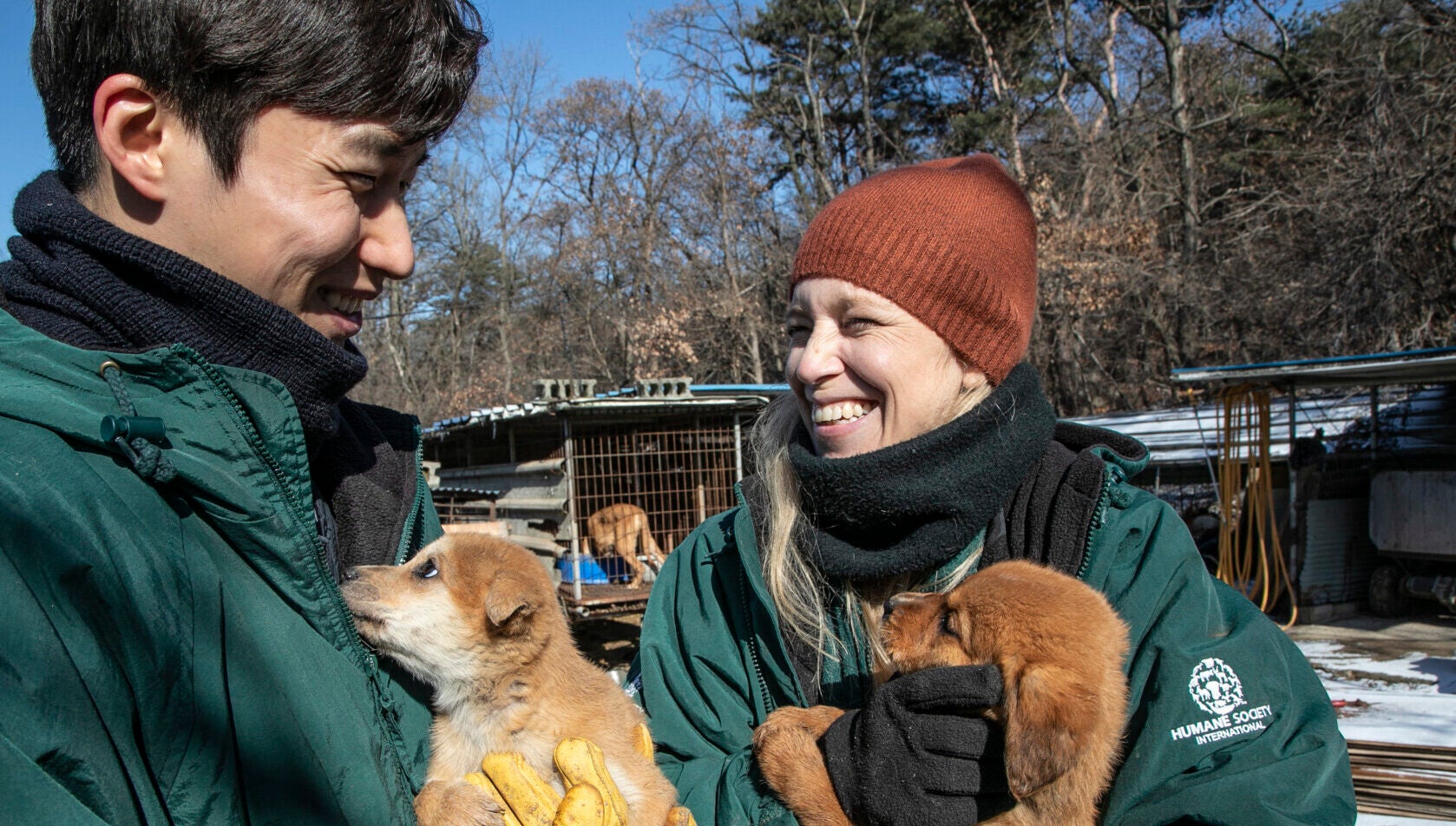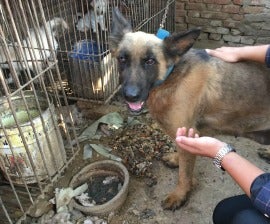
South Korea is the only known country in the world where dogs are intensively farmed for human consumption. Over 500,000 dogs are confined in thousands of dog meat farms across the country, exposed to the elements in small, barren, filthy cages, with minimal food and water. Many suffer from disease and malnutrition, and all endure severe daily neglect. The methods used to kill these dogs are brutal, with electrocution being the most common. They are slaughtered in full view of other dogs, making their final moments both painful and terrifying.
HSI’s goal has been to secure a ban on the dog meat industry. Our efforts to close dog meat farms have been a key part of a successful strategy to create the political and societal momentum necessary to pass a legislative ban. This culminated in the South Korea National Assembly’s decision in January 2024 to ban the industry. A crucial factor in building political support has been demonstrating that the dog meat industry can be phased out in cooperation with, rather than conflict with, farmers. Since 2015, HSI/Korea has worked with dog meat farmers who are eager to leave the industry, helping them shut down their operations and transition to humane livelihoods with the dogs voluntarily handed over to HSI for adoption.
While some of the dogs we rescue find loving homes in South Korea, many are flown to other countries for adoption due to the low adoption culture in this country, where people generally prefer to buy small pedigree dogs. There is also a misconception among some that “meat dogs” are different from “pet dogs.” We are working to change this perception through public education and sharing adoption stories that clearly show there is no difference between pet dogs and dog meat dogs with the aim of increasing shelter adoption in South Korea.
Rescues
Farm closure 1: January 2015 was HSI’s first farm closure where 23 dogs were rescued, the farm closed and HSI supported the farmer switching to blueberry farming. All 23 dogs were flown to the United States, divided among five Washington D.C. area shelters, and have been adopted into loving homes as family pets. Many of them act as ambassadors for our campaign.
Farm closure 2: took place in March 2015 in Hongseong, this time rescuing 60 dogs—a mixture of breeds including beagles, poodles, Korean Jindos and large Tosas. Once again, the farmer ended dog meat farming for good. Tae Hyung Lee had bred dogs for meat for 20 years; facing criticism from family members for his participation in this cruel trade, he was eager to work with HSI to close his farm and start a new business. All but two of the 60 dogs now live in the United States, in loving, caring environments, with two (a mother and pup poodle) happily adopted in South Korea.
Farm closure three September 2015 was our largest yet, rescuing all 123 dogs from a farm in Chungcheongnam-do. All 123 dogs—a mixture of breeds ranging from the large mastiffs most often considered as “meat dogs” in South Korea, to Jindo mixes, Spaniel mixes and Chihuahuas–were transported to shelters in California, Oregon and Washington State in the United States.
Farm closure four In December 2015, HSI rescued 27 dogs and puppies from a small “starter” dog meat farm in South Korea. The dogs were flown to the United States and divided among five area shelters for care and adoption.
Farm closure five: This was a rescue conducted in two parts, in total rescuing 267 dogs. Part one took place in February 2016, rescuing 50 dogs from a dog meat farm in Wonju; part two took place in April 2016, rescuing the remaining 217 dogs. The dogs from this farm are a mixture of breeds including Husky, Labrador, Golden Retriever, Mastiff and Jindo mixes.
Chicken Farm Dog Rescue: In July 2016, Humane Society International worked with Free Korean Dogs to assist a local activist called Jinoak in South Korea with re-homing dogs who had been rescued from a dog meat farm. Jinoak had discovered the dog meat farm containing 51 dogs, bought them from the farmer, and built a shelter to house the dogs. With assistance from Free Korean Dogs, Jinoak placed some of the dogs for adoption, and HSI stepped in to help re-home the remaining dogs. One of HSI’s Shelter and Rescue Partners in Helena, Montana, in the United States—Lewis and Clark Humane Society—agreed to take the dogs. One dog found an adopter online and was flown directly to Toronto to his new home.
Jeonju Farm Dog Rescue: In September 2016, HSI worked again with Free Korean Dogs to rescue 31 dogs from a dog meat farm after Korean authorities ordered the farm to shut down for operating illegally without a license. HSI assisted with re-homing five of the dogs.
Farm closure six: In January 2017, HSI closed a farm in Wonju and rescued all 219 dogs, flown to the United States, Canada and the United Kingdom for adoption. The farmer, a mother with a teenage daughter, was keen to leave the trade and move to the city to start a better life for herself and her child.
Farm closure seven: In March 2017, HSI closed down a farm in Goyang and rescued all 67 dogs, flown to the United States for adoption. The elderly farmer and his wife were keen to retire due to age, ill health and their increasing unease at breeding dogs for eating—in fact the farmer had stopped selling his dogs for slaughter and stopped eating dog himself.
Farm closure eight: In June 2017, 16 dogs were rescued by HSI from a small backyard breeding operation in Seongnam (total includes two puppies born to one of the mama dogs shortly after we rescued her). The owner bred the dogs to sell to a nearby dog meat market. All the dogs were transported to the United States for adoption.
Farm closure nine: In July 2017, HSI closed a dog farm in Yesan and rescued all 149 dogs from the property, including 14 newborn pups. The dogs were flown to the United States to find homes.
Gongju city farm rescue: In October 2017, HSI/Korea assisted Korean animal partners KAWA in rescuing 23 dogs, mainly Tosas, from a farm in Gongju city.
Farm closure 10: In November/December 2017, HSI closed a dog meat farm in Namyangju rescuing more than 170 dogs, who were flown to the United States, Canada and the United Kingdom to find new homes.
Farm closure 11: In March 2018, HSI closed a small dog meat farm in Gyeonggi-do province, with 105 dogs and puppies transported to Canada.
Farm closure 12: In June 2018, HSI reached an agreement with a farmer in Namyangju-si, Gyeonggi-do to remove the last 50 dogs from his dog meat farm before he shut it down to expand his more profitable water parsley business. We flew the dogs to Canada to start their new lives.
Farm closure 13: In October 2018, we worked with Farmer Lee in Gyeonggi-do, South Korea to shut down his dog meat farm after 14 years, rescuing 200 dogs and flying them to Shelter and Rescue Partners in the United States, Canada, the United Kingdom and the Netherlands. Lee plans to expand his medicinal herb farm instead.
Farm closure 14: In February 2019, HSI closed a dog farm in Hongcheon with nearly 200 dogs, including a combined puppy mill operation.
Gupo dog meat market rescue: In July 2019, HSI/Korea worked with Korean partners KAWA, KARA and Busan Korean Alliance for Prevention of Cruelty to Animals, and alongside local authorities to rescue 85 dogs from Gupo dog meat market in Busan upon its closure.
Farm closure 15: In September 2019, HSI closed down a dog farm in Gyeonggi-do with more than 90 dogs and puppies.
Farm closure 16: In May 2020, HSI closed down a dog farm in Hongseong-gun, rescuing more than 70 dogs and puppies.
Farm closure 17: In October 2020, HSI shut a dog meat farm in Haemi and saved 170+ dogs from the dog meat trade.
Paju rescue: In October 2020, HSI/Korea assisted local groups with the rescue of 14 Jindo dogs from a small farm which the farmer had agreed to close.
Gimpo rescue: In December 2020, HSI/Korea assisted Korean partners LIFE and regional officials in rescuing more than 100 poodles, Jindos, Yorkshire terriers, Chihuahuas, Shih Tzus, Pomeranians, Spitz, Schnauzers and more caged in deplorable conditions on a junkyard farm where they had been bred and sold for both the pet trade and the dog meat trade.
Yongin rescue: In April 2021, HSI/Korea joined with Korean animal protection groups LIFE, KoreanK9Rescue and Yongin Animal Care Association to save 50 dogs from being euthanized on a dog meat farm in Yongin city after the facility was closed down by the authorities.
Jindo Island farm closure: In August 2021, HSI/Korea assisted our Korean partners LIFE to rescue 65 Jindo dogs and puppies from a farm on Jindo Island. The farm was being investigated and shut down by local authorities for having breached the Animal Protection Act due to dogs being killed in front of each other.
Ansan rescue: In July 2022, HSI/Korea assisted Korean K9 Rescue in removing 21 dogs left behind when Ansan city authorities closed an illegal dog meat farm in Gyeonggi-do, South Korea. Officials had already removed 38 dogs to their shelter for rehoming, but left 21 behind with a deadline for removal or they would be at risk of being euthanized or sold to a slaughterhouse. The farmer had been breeding dogs for human consumption at the site for six years.
Farm closure 18: In March 2023, HSI/Korea closed down a farm in Asan-si, Chungcheong province and rescued 200 dogs and puppies on the property. The farmer, Mr. Yang, planned to retire and grow vegetables to sell locally.












